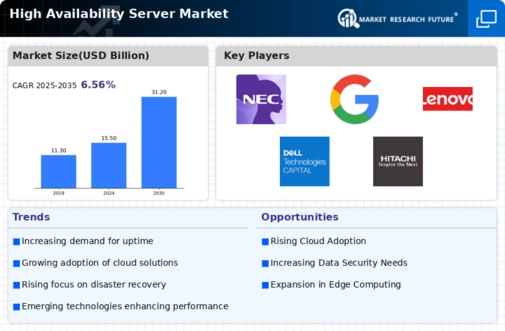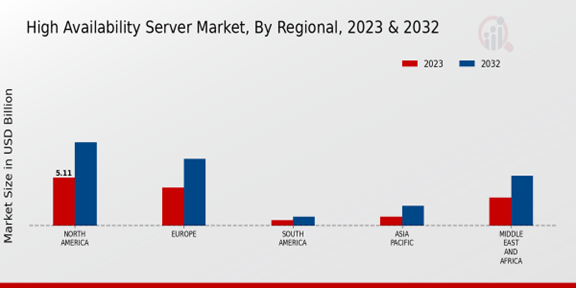Market Growth Projections
The Global High Availability Server Market Industry is projected to experience substantial growth over the coming years. With a market value expected to reach 15.5 USD Billion in 2024 and 31.2 USD Billion by 2035, the industry is on a promising trajectory. The anticipated compound annual growth rate (CAGR) of 6.56% from 2025 to 2035 indicates a robust demand for high availability solutions across various sectors. This growth is driven by factors such as increasing reliance on technology, the need for uninterrupted service, and the adoption of cloud-based solutions. As organizations prioritize operational resilience, the Global High Availability Server Market Industry is poised for significant expansion.
Increasing Demand for Uptime
The Global High Availability Server Market Industry experiences a rising demand for uninterrupted service across various sectors. Organizations are increasingly reliant on technology for their operations, necessitating systems that ensure minimal downtime. This trend is particularly evident in industries such as finance and healthcare, where even a few minutes of downtime can result in substantial financial losses. As a result, the market is projected to reach 15.5 USD Billion in 2024, reflecting the critical need for high availability solutions. Companies are investing in redundant systems and failover mechanisms to enhance their operational resilience, thereby driving growth in the Global High Availability Server Market Industry.
Rising Cybersecurity Threats
The escalating threat of cyberattacks significantly impacts the Global High Availability Server Market Industry. Organizations are increasingly aware of the need for robust security measures to protect their systems from potential breaches that could lead to downtime. High availability servers are being adopted as part of comprehensive cybersecurity strategies, ensuring that critical services remain operational even during attacks. This heightened focus on security not only drives demand for high availability solutions but also encourages investments in advanced technologies that enhance system resilience. As cybersecurity threats continue to evolve, the Global High Availability Server Market Industry is likely to see sustained growth.
Cloud Adoption and Hybrid Solutions
The shift towards cloud computing and hybrid solutions significantly influences the Global High Availability Server Market Industry. As businesses migrate to cloud environments, the demand for high availability servers that can seamlessly integrate with cloud infrastructure increases. This trend is driven by the need for scalability, flexibility, and cost-effectiveness. Organizations are looking for solutions that provide high availability in both on-premises and cloud environments, which enhances their operational efficiency. The market is expected to grow substantially, with projections indicating a value of 31.2 USD Billion by 2035. This growth underscores the importance of high availability servers in supporting hybrid cloud strategies.
Regulatory Compliance and Data Protection
Regulatory compliance and data protection requirements are pivotal drivers in the Global High Availability Server Market Industry. Organizations must adhere to stringent regulations concerning data security and privacy, which necessitates the implementation of high availability solutions. Industries such as finance, healthcare, and telecommunications face rigorous compliance standards that mandate continuous availability of services. As a result, businesses are investing in high availability servers to ensure they meet these legal obligations while safeguarding sensitive data. This trend not only enhances operational reliability but also fosters customer trust, thereby propelling the growth of the Global High Availability Server Market Industry.
Technological Advancements in Server Infrastructure
Technological advancements in server infrastructure play a crucial role in shaping the Global High Availability Server Market Industry. Innovations such as virtualization, containerization, and improved network technologies enable organizations to deploy high availability solutions more effectively. These advancements facilitate better resource utilization, reduced latency, and enhanced performance, which are essential for maintaining service continuity. As companies seek to leverage these technologies, the market is poised for growth, with a projected CAGR of 6.56% from 2025 to 2035. This growth reflects the increasing reliance on sophisticated server infrastructures to support high availability requirements.







